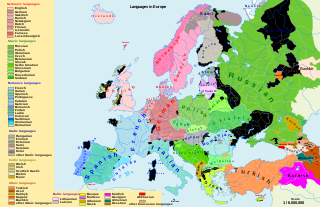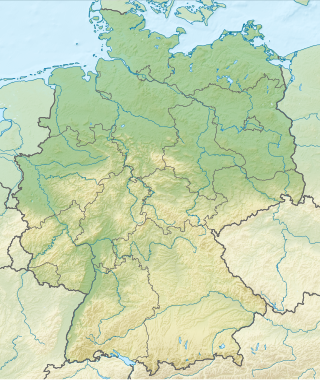
Northwestern Europe, or Northwest Europe, is a loosely defined subregion of Europe, overlapping Northern and Western Europe. The term is used in geographic, [1] history, [2] and military contexts. [3]

Northwestern Europe, or Northwest Europe, is a loosely defined subregion of Europe, overlapping Northern and Western Europe. The term is used in geographic, [1] history, [2] and military contexts. [3]
Geographically, Northwestern Europe is given by some sources as a region which includes Great Britain, [4] Ireland, [4] Belgium, [5] the Netherlands, [5] Luxembourg, [6] Northern France, [5] parts of or all of Germany, [7] [6] Denmark, [4] Norway, [6] Sweden, [6] and Iceland. [2] [8] In some works, Switzerland, Finland, and Austria are also included as part of Northwestern Europe. [6]
Under the Interreg program, funded by the European Regional Development Fund, "North-West Europe" (NWE) is a region of European Territorial Cooperation that includes Belgium, Ireland, Luxembourg, Switzerland, the Netherlands and parts of France and Germany. [7]
During the Reformation, some parts of Northwestern Europe converted to Protestantism, [9] in a manner which differentiated the region from its Catholic neighbors elsewhere in Europe. [10] [11]
A definition of Northwestern Europe was used by some late 19th to mid 20th century anthropologists, eugenicists, and Nordicists, who used the term as a shorthand term for the part of Europe with a predominantly Nordic population. [12] [13] [14] [15] For example, Arthur de Gobineau, the 19th-century aristocrat who published works on the pseudoscience of scientific racism, included parts of Northwestern Europe in what Leon Baradat described as his "Aryan heaven". [16]
There is close genetic affinity among some Northwest European populations, [17] with some of these populations descending from Bell Beaker populations carrying steppe ancestry.[ citation needed ] For example, the Beaker people of the lower Rhine overturned 90% of Great Britain's gene pools, replacing the Basque-like neolithic populations present prior. [18]

There are over 250 languages indigenous to Europe, and most belong to the Indo-European language family. Out of a total European population of 744 million as of 2018, some 94% are native speakers of an Indo-European language. The three largest phyla of the Indo-European language family in Europe are Romance, Germanic, and Slavic; they have more than 200 million speakers each, and together account for close to 90% of Europeans.

Western Europe is the western region of Europe. The region's extent varies depending on context.

The European region known as the Low Countries, historically also known as the Netherlands or Belgica, is a coastal lowland region in Northwestern Europe forming the lower basin of the Rhine–Meuse–Scheldt delta and consisting today of the three modern "Benelux" countries: Belgium, Luxembourg, and the Netherlands – which English and French give the same name as the traditional regional name. Geographically and historically, the area also includes parts of France and Germany such as French Flanders and the German regions of East Frisia and Cleves. During the Middle Ages, the Low Countries were divided into numerous semi-independent principalities.

The Bell Beaker culture, also known as the Bell Beaker complex or Bell Beaker phenomenon, is an archaeological culture named after the inverted-bell beaker drinking vessel used at the very beginning of the European Bronze Age, arising from around 2800 BC. Bell Beaker culture lasted in Britain from c. 2450 BC, with the appearance of single burial graves, until as late as 1800 BC, but in continental Europe only until 2300 BC, when it was succeeded by the Unetice culture. The culture was widely dispersed throughout Western Europe, being present in many regions of Iberia and stretching eastward to the Danubian plains, and northward to the islands of Great Britain and Ireland, and was also present in the islands of Sardinia and Sicily and some coastal areas in north-western Africa. The Bell Beaker phenomenon shows substantial regional variation, and a study from 2018 found that it was associated with genetically diverse populations.

Central European Time (CET) is a standard time of Central, and parts of Western Europe, which is one hour ahead of Coordinated Universal Time (UTC). The time offset from UTC can be written as UTC+01:00. It is used in most parts of Europe and in a few North African countries. CET is also known as Middle European Time and by colloquial names such as Amsterdam Time, Berlin Time, Brussels Time, Budapest Time, Madrid Time, Paris Time, Rome Time, Prague time, Warsaw Time or Romance Standard Time (RST).

Western European Time is a time zone covering parts of western Europe and consists of countries using UTC±00:00. It is one of the three standard time zones in the European Union along with Central European Time and Eastern European Time.
Europe, the westernmost portion of Eurasia, is often divided into regions and subregions based on geographical, cultural or historical factors. Since there is no universal agreement on Europe's regional composition, the placement of individual countries may vary based on criteria being used. For instance, the Balkans is a distinct geographical region within Europe, but individual countries may alternatively be grouped into South-eastern Europe or Southern Europe.

Atlantic Europe is a geographical term for the western portion of Europe which borders the Atlantic Ocean. The term may refer to the idea of Atlantic Europe as a cultural unit and/or as a biogeographical region.
A regional language is a language spoken in a region of a sovereign state, whether it be a small area, a federated state or province or some wider area.

Europe is traditionally defined as one of seven continents. Physiographically, it is the northwestern peninsula of the larger landmass known as Eurasia ; Asia occupies the centre and east of this continuous landmass. Europe's eastern frontier is usually delineated by the Ural Mountains in Russia, which is the largest country by land area in the continent. The southeast boundary with Asia is not universally defined, but the modern definition is generally the Ural River or, less commonly, the Emba River. The boundary continues to the Caspian Sea, the crest of the Caucasus Mountains, and on to the Black Sea. The Bosporus, the Sea of Marmara, and the Dardanelles conclude the Asian boundary. The Mediterranean Sea to the south separates Europe from Africa. The western boundary is the Atlantic Ocean. Iceland is usually included in Europe because it is over twice as close to mainland Europe as mainland North America. There is ongoing debate on where the geographical centre of Europe falls.

The Nordwestblock is a hypothetical Northwestern European cultural region that some scholars propose as a prehistoric culture in the present-day Netherlands, Belgium, far-northern France, and northwestern Germany, in an area approximately bounded by the Somme, Oise, Meuse and Elbe rivers, possibly extending to the eastern part of what is now England, during the Bronze and Iron Ages from the 3rd to the 1st millennia BCE, up to the onset of historical sources, in the 1st century BCE.

UTC+01:00 is an identifier for a time offset from UTC of +01:00. In ISO 8601, the associated time would be written as 2019-02-07T23:28:34+01:00. This time is used in:

Religion has been a major influence on the societies, cultures, traditions, philosophies, artistic expressions and laws within present-day Europe. The largest religion in Europe is Christianity. However, irreligion and practical secularisation are also prominent in some countries. In Southeastern Europe, three countries have Muslim majorities, with Christianity being the second-largest religion in those countries. Ancient European religions included veneration for deities such as Zeus. Modern revival movements of these religions include Heathenism, Rodnovery, Romuva, Druidry, Wicca, and others. Smaller religions include Indian religions, Judaism, and some East Asian religions, which are found in their largest groups in Britain, France, and Kalmykia.
Interreg is a series of programmes to stimulate cooperation between regions in and out of the European Union (EU), funded by the European Regional Development Fund. The first Interreg started in 1989. Interreg IV covered the period 2007–2013. Interreg V (2014–2020) covers all 27 EU member states, the EFTA countries, six accession countries and 18 neighbouring countries. It has a budget of EUR 10.1 billion, which represents 2.8% of the total of the European Cohesion Policy budget. Since the non EU countries don't pay EU membership fee, they contribute directly to Interreg, not through ERDF.

Christianity is the largest religion in Europe. Christianity has been practiced in Europe since the first century, and a number of the Pauline Epistles were addressed to Christians living in Greece, as well as other parts of the Roman Empire.
The 1973 Federation Cup was the 11th edition of the most important competition between national teams in women's tennis. 30 nations participated in the tournament, which was held at the Bad Homburg Tennis Club in Bad Homburg, West Germany from 30 April–6 May. Australia defeated South Africa in the final, winning the title without losing a rubber.

The Greater Region, formerly also known as SaarLorLux, is a euroregion of eleven regional authorities located in four European states. The term has also been applied to cooperations of several of these authorities or of their subdivisions, administrations, organisations, clubs and people. Member regions represent different political structures: the Walloon region, comprising the French and German-speaking Communities of Belgium; the former Lorraine part of Grand Est, a region of France, including the French departments Meurthe-et-Moselle, Meuse, Moselle and Vosges; the German federated states of Rhineland-Palatinate and Saarland; and the sovereign state of Luxembourg.

Germany is a country in Central and Western Europe that stretches from the Alps, across the North European Plain to the North Sea and the Baltic Sea. It is the second-most populous country in Europe after Russia, and is seventh-largest country by area in the continent. The area of Germany ranked 63rd and covers 357,021 km2 (137,847 sq mi), consisting of 349,223 km2 (134,836 sq mi) of land and 7,798 km2 (3,011 sq mi) of waters, smaller than Japan but larger than Republic of the Congo.
The EuroBasket Women 2023 qualification was held from November 2021 to February 2023 to decide the 14 teams to join the co-hosts Israel and Slovenia. It featured 38 teams split in ten groups of three or four teams. The ten group winners and the four best second-ranked teams qualified for the final tournament.
the area covered is northwestern Europe [..including..] the Atlantic coasts of Britain, Ireland and northern France, together with all English Channel coastlines and the fringes of the North Sea as far east as Skagerrak, and as far north as [..] Bergen in Norway
Northwestern Europe: Austria, Belgium, Denmark, Finland, France, Germany, Iceland, Ireland, Luxembourg, Netherlands, Norway, Scotland, United Kingdom, Switzerland
The North-West Europe area [..] programme covers Belgium, Ireland, Luxembourg, The Netherlands, Switzerland as well as parts of France and Germany
Protestantism swept over those countries of northwestern Europe which have large proportions of Nordic elements represented in their populations
Most of northwestern Europe converted to Protestantism, while most of southwestern Europe remained Catholic. Whether climate or ethnicity (northwestern Europe was more Germanic, southwestern Europe more latin) was the greater factor in this division remains a matter of dispute
The old immigrants, from northwestern Europe (Ireland, Great Britain, France, the Netherlands, the German states, and Scandinavia) [..] were primarily Protestants (except the Irish, who were mostly Catholic)
Extending across northwestern Europe, Gobineau's Aryan heaven included Ireland, England, northern France [..], the Benelux countries and Scandinavia
A statistical summary of genetic data from 1,387 Europeans based on principal component axis one (PC1) [..] may reflect a special role for this geographic axis in the demographic history of Europeans [..] PC1 aligns north-northwest/south-southeast
migration played a key role in the further dissemination of the Beaker Complex, a phenomenon we document most clearly in Britain, where the spread of the Beaker Complex [..] was associated with a replacement of ~90% of Britain's gene pool within a few hundred years